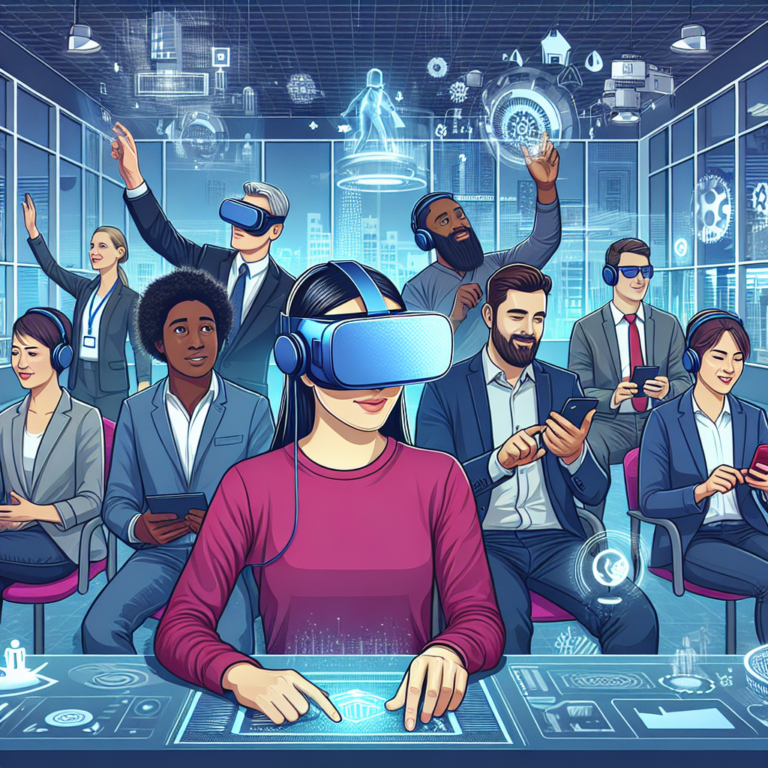Transforming Workforce Training: How Immersive Technologies Are Shaping the Future
Understanding Immersive Technologies
In today’s fast-paced world, traditional methods of workforce training are rapidly being replaced by immersive technologies. This exciting field encompasses virtual reality (VR), augmented reality (AR), and mixed reality (MR), all of which are unlocking new ways to engage learners and enhance skill development. By transgressing the boundaries of conventional learning, these technologies enable employees to practice and refine their skills in highly realistic environments.
The Advantages of Using Immersive Technologies in Training
Employing immersive technologies for workforce training offers a plethora of benefits that can considerably improve learning outcomes:
- Enhanced Engagement: Immersive experiences capture the attention of learners, making training programs not just informative, but also entertaining. Employees are more likely to retain information when it is presented in an engaging format.
- Realistic Simulations: These technologies create lifelike scenarios that allow employees to practice their skills without real-world consequences. This kind of practice is invaluable in high-stakes industries like healthcare, aviation, and manufacturing.
- Cost-Effective Solutions: Although the initial investment in immersive technology can be significant, the long-term savings through decreased training time and improved productivity make it a wise investment.
- Accessibility: Immersive learning can be accessed from anywhere, empowering remote workers and making training opportunities available to a broader audience.
How Virtual Reality (VR) Transforms Skill Development
Virtual reality stands out as one of the most impactful immersive technologies. By wearing a VR headset, employees can step into a digital realm where they can interact with 3D environments and scenarios tailored to their job roles. Here’s how VR is changing the training landscape:
- Safe Learning Environment: VR allows employees to engage in scenarios where mistakes can be made without real-life repercussions. This promotes confidence and learning through trial and error.
- Customized Training Programs: VR solutions can be tailored to specific company needs, making training programs more relevant and effective.
- Instant Feedback: Many VR training modules incorporate analytics that provides instant feedback to learners, allowing them to improve continuously.
Exploring Augmented Reality (AR) for On-the-Job Learning
Augmented reality bridges the gap between the physical and digital worlds. By overlaying digital information and visuals onto real-world environments, AR empowers employees to learn as they work. Some applications of AR in workforce training include:
- Guided Installations: Workers can receive step-by-step instructions through AR glasses or devices while performing complex tasks, reducing errors and saving time.
- Maintenance Support: AR can provide technicians with real-time data visualization and instructions, enabling them to repair machinery more efficiently.
- Enhanced Collaboration: Teams working on a project can communicate and share ideas in an immersive environment, improving collective problem-solving.
Mixed Reality (MR): The Best of Both Worlds
Mixed reality combines elements of both VR and AR to create a unique training environment where digital objects interact with the real world. MR can be particularly beneficial in the following ways:
- Training Mechanics: Employees can use MR to practice physical tasks while receiving real-time feedback on their techniques.
- Collaborative Learning: Team members can work together in a shared mixed-reality space, even when they are physically apart, promoting teamwork and communication.
- Interactive Problem Solving: By manipulating virtual elements in a real-world context, learners can experiment and see immediate results, fostering deeper understanding.
Key Industries Benefiting from Immersive Training
While immersive technologies can be applied across a range of sectors, some industries are particularly reaping the rewards:
- Healthcare: Medical professionals utilize VR for surgical simulations and AR for enhancing patient care through guided procedures.
- Aerospace: Pilots can train in realistic simulations without set limitations, honing their skills in various flight scenarios.
- Manufacturing: Workers can learn to operate complex machinery with augmented instructions, ensuring high levels of safety and efficiency.
- Retail: Sales teams can practice customer interactions in a virtual setting, improving their communication and sales techniques.
Implementing Immersive Technologies: Key Considerations
For organizations looking to adopt immersive technologies into their training programs, here are some essential aspects to consider:
- Define Clear Objectives: Understanding what you want to achieve with immersive training will guide your technology choices and program structure.
- Involve Stakeholders: Engage with employees and managers to gather input and insights into what training methods they find most effective.
- Evaluate Content Quality: Invest in high-quality training content to ensure that the immersive experience is both educational and engaging.
- Monitor and Adapt: Continuously assess the effectiveness of immersive training programs and make necessary adjustments based on feedback and performance data.
The Future: Immersive Technologies in Workforce Training
As we advance into a technology-driven future, the role of immersive training is set to expand even further. Innovations in AI, machine learning, and enhanced 3D graphics will continue to create more realistic and intuitive training experiences.
Embracing immersive technologies in workforce training and development is not just about keeping up with trends; it represents a fundamental shift towards more effective, engaging, and dynamic learning methodologies. As businesses align themselves with these innovations, they position themselves—and their workforce—at the forefront of industry advancements.




0 Comments